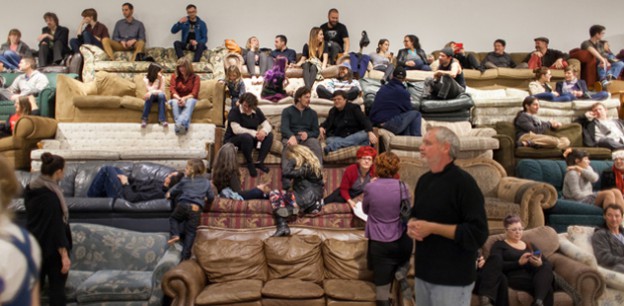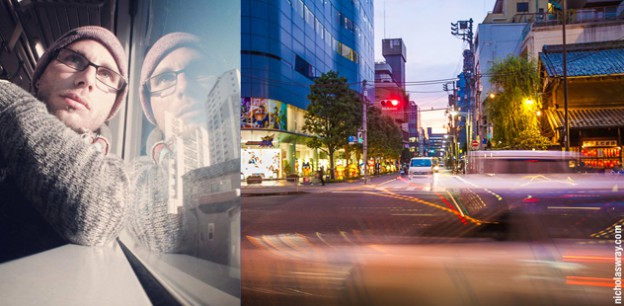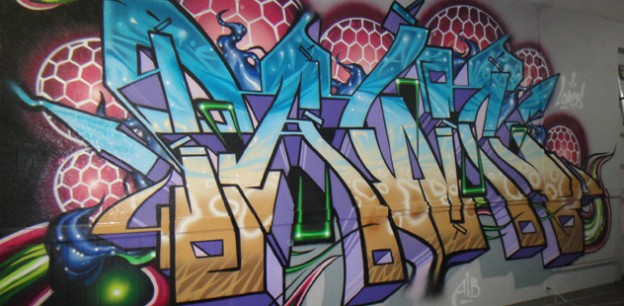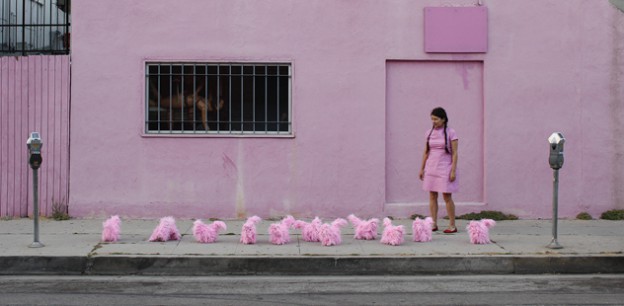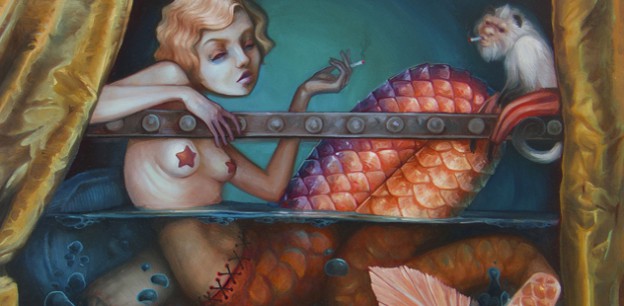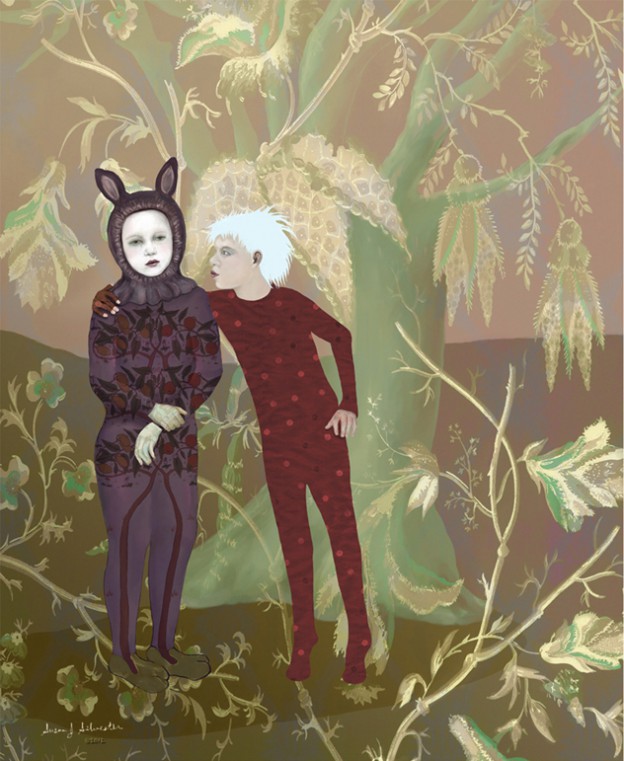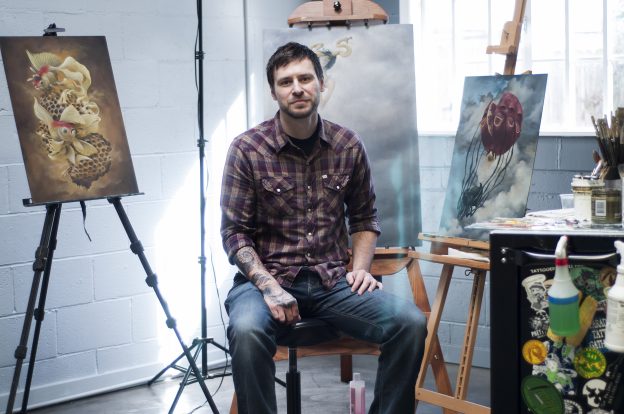Artist Nate Page takes couch-surfing to a new level in his latest exhibit at Verge Center for the Arts
Sacramento has proven itself a thriving community for the arts, and there has been no shortage of artists wanting to showcase their wares at various galleries. And while most people equate art with the upper crust set and formal gatherings, many of the area’s hottest spots for seeing current pieces by emerging artists are, for the most part, lowbrow affairs.
One artist from Los Angeles’ Boyle Heights area, 39-year-old Nate Page, has made considerable headway across the country and even on an international level with his revelatory work and keen attention to nuance and detail.
Verge Center for the Arts, which is curated by the thoughtful Liv Moe, has opened its doors to Page’s Couchbleachers installation, which is literally a 55-foot-long bank of bleachers made up of wood and couches found in Sacramento. In turn, the installation has inspired a dedicated movie series—Friday Lunch Hour Movies—for those Sacramento workers who can enjoy a long lunch without any repercussions from his/her respective bosses.
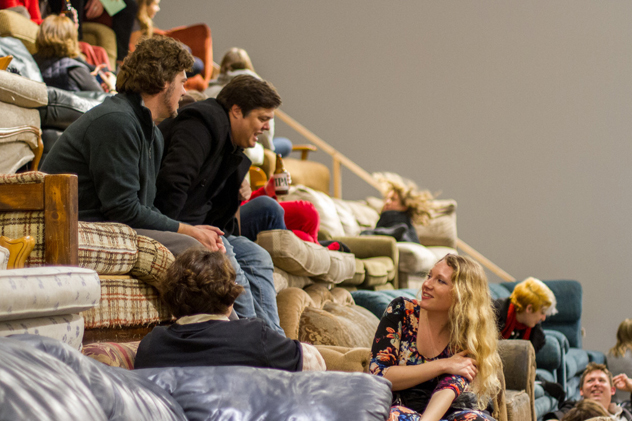
Page, however, has earned himself considerable accolades and some tidy sums of money in the way of scholarships and grants through his efforts working outside the box.
Although a part-time teacher by day to make ends meet, his greatest love is creating inspirational works that are not only functional and thought-provoking but also can be of use.
From his humble beginnings in Wisconsin through his time spent in New York and California, art has afforded Page the ability to be a part of many spectacles in different countries and cities. During a recent phone interview, he seemed very enthusiastic about his future.
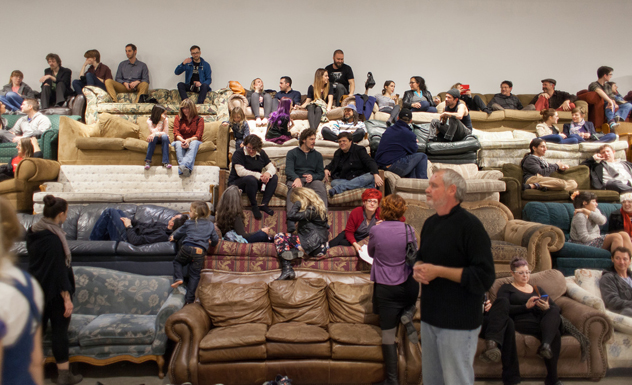
It’s no secret you’ve been doing art for most of your adult life. I love the art on your website and the different styles you’ve incorporated over the years. How did you get started?
My family actually was really not that into it. I think it all began when I just started doing stuff and making things by myself when I was kid. My grandfather, who recently turned 95, was a sign painter, and he got me thinking about making big pictures and things of a bigger scale. Come to think of it, he was always interested in what I was doing and was a big supporter of me in general although he didn’t understand most of it.
Are you able to make a full-time living from your art? What is your other day job?
I definitely need to work to pay bills. I teach a design class at Woodbury University in Burbank and am an adjunct professor in design. Right now I get anywhere from one to three days a week on the average, but it is my steadiest income source. Additionally, I love teaching and it’s totally another side of what I do. A lot of artists don’t teach since they can’t deal with students or don’t know how to interact on a personal level.
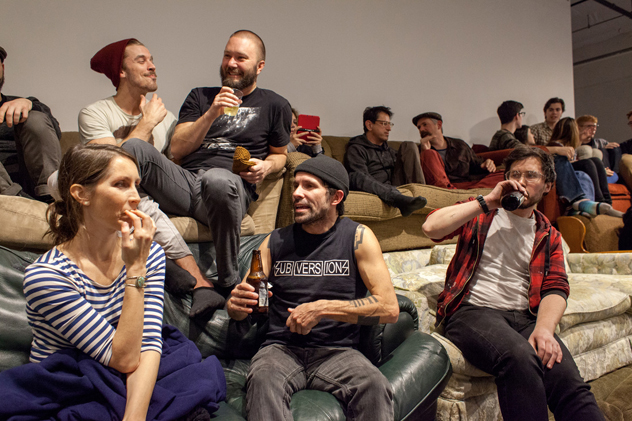
How did the Couchbleachers installation idea come about?
In 2011 I had the first Couchbleachers exhibit in Cleveland with Machine Project, a loose network run by Mark Allen that does a lot of installation. It was at a venue called Spaces Gallery and I just wanted to make something unique that was usable. A general contractor was hired to help create the piece while I drew up the plans and worked everything out as well. We also found new solutions about doing things of a larger scale. Since I often collaborate with different people and get help from venue staff to help, it can be beneficial to both parties. Since they already have a system set up in advance to deal with civic-scale environments, I often work that way.
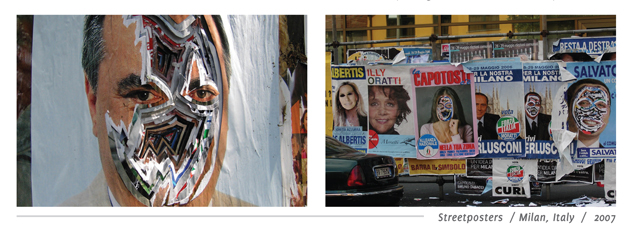
Have you ever thought about working in tandem with live musicians to create stage sets and costumes? It seems right up your alley given a lot of your specialized art [referring to his face art from Italy installation featured on his website].
Honestly, I’ve never done it. I’ve also never really had the opportunity to think about it since nobody has approached me for it. I’d definitely be interested in doing something, but I’d really need to get into the mindset of the band as a whole enterprise. Once more, it would be extremely important to understand and know the original intentions of the venue and artist and what they’re trying to emphasize and not.
Do you have any plans to include any other artists on current projects?
I don’t have any plans to collaborate with anyone. I only work with people in the institutional sense since they help me create the bridge to reality and produce what’s in my mind or on paper. Although I have done a lot of collaborating in the past, I’m in the headspace now where I want to work solo only.
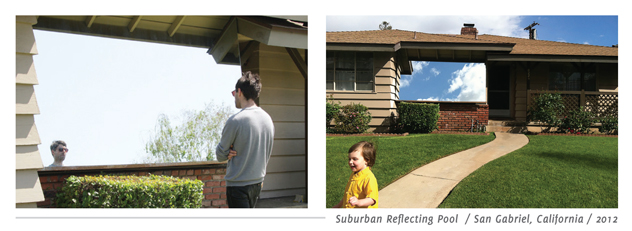
You’ve moved around quite a bit and have been anything but sedentary for most of your life, correct?
True. However, I have been living in Los Angeles for nine years, New York for six years and grew up in the small town of Waukesha, Wisconsin, which is a suburb of nearby Milwaukee. I used to live in Milwaukee as well right across the street from Eagles Ballroom [the area’s most popular live music venue]. There is a restaurant named Steny’s Tavern and Grill where I was a cook. It was a full-on biker hangout. It was a great job since I got all my meals for free and got to hang out with lots of Harley riders. Since Harley was developed in Wisconsin, it was very commonplace around there (and still is) to see bikers everywhere.
Tell us about your Cooper Union Summer Residency Program in New York City?
That was actually one where you needed to apply. It was much less personal than all the other residencies since it came with formalities and I was, ultimately, on a scholarship to go there. They gave me enough to get by but not to live on. At the time I was also dating a woman who was coincidentally from Milwaukee and lived there with her for roughly three years in the SoHo district. After we split up, I later moved into my own place in Bushwick [section of Brooklyn].
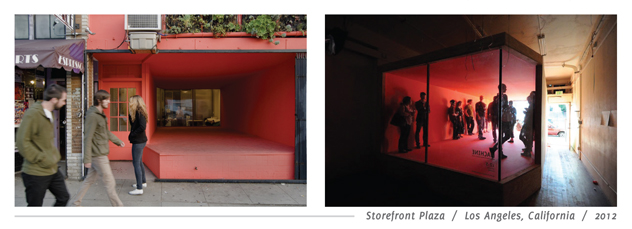
And what about your residencies abroad in Austria and Italy?
This well-known Austrian artist Heimo Wallner was doing a show in Milwaukee and somehow we got introduced. For some reason, we ended up at both my studio and my apartment and he liked what he saw obviously. At the time, I was living in there with my girlfriend and she had turned everything in the house including furniture and fixtures upside down at my apartment. We were in a fight at the time, and I totally forgot the place was a wreck. It seemed like he was more impressed by that visual than anything else but my artwork ended up getting me the gig at Hotel Pupik, Austria. Heimo was a big supporter of my early art life, and I thank him immensely for the guidance. In 2006, I had another installation at O’Artoteca in Milan, Italy. That one happened through a woman friend of mine named Sara Serighelli who I knew from my previous residency in Austria. It was very organic and she simply asked me one day after months of continued contact.
School is expensive and you’ve attended three different ones in three different states. Explain how it all worked out.
My parents helped me for undergraduate work but, unfortunately, I still have a decent amount of debt. I stay in contact with collectors, but, honestly, I simply tell them I don’t have it. I don’t have the extra money and they’re not going to get it while I need money for supplies and living expenses. Art school is ridiculous when you look at the money you pay and then the money you’re projected to get paid with that degree. You usually have to do a couple of different jobs to make ends meet and some people give up altogether. I’ve managed to make it work so far. I got the California Community Foundation Emerging Artist Fellowship grant for $15,000 a while back and have gotten others which have helped but were much smaller.
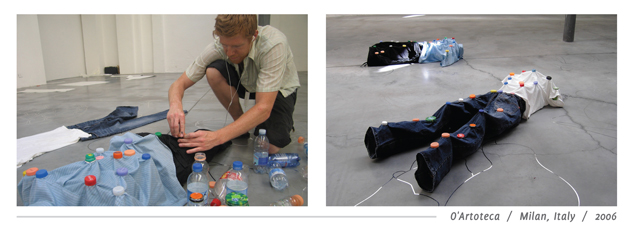
You’ve mentioned you like working solo. Is there any chance you’ll date again given your experience with furniture-arranging ex-girlfriends?
Right now I don’t have a girlfriend but you could say something is brewing. I’ll give it to you off the record, though.

Nate Page’s Couchbleachers runs Wednesday through Saturday from 11 a.m. to 6 p.m. and Sundays from 12 p.m. to 5 p.m. He’ll also be a featured speaker at Verge Center For The Arts’ In Conversation series on Wednesday, March 11 at 6:30 p.m. All ages are welcome and the event is free (although a $5 donation is suggested). For a full list of events, including a schedule of the remaining Friday Lunch Hour Movies and the upcoming Verge All Nighter slumber party/film festival, go to Vergeart.com. Verge Center for the Arts is located at 625 S Street, Sacramento.
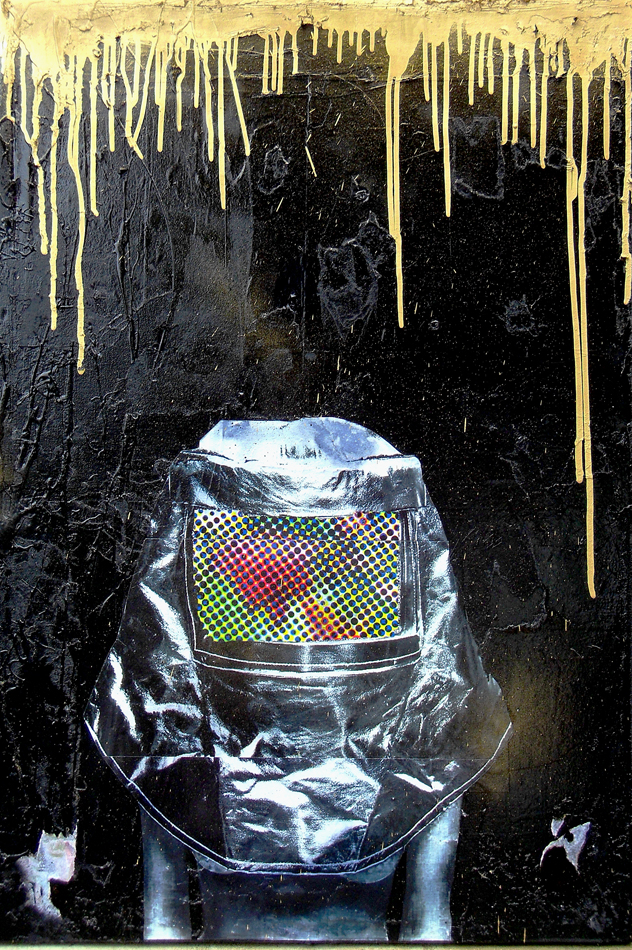
Ever since they opened up shop in late 2014 in East Sacramento, White Buffalo Gallery has been straight up killing it with their monthly art exhibits. The front half of the space serves as the hip and clean art gallery, and the back half, separated by a perfectly designed partition in the wall, is a spotless tattoo shop where owner Ryan “El Dugi” Lewis and fellow artists/tattooers John Laurent and Kenneth Villanueva do their thing. White Buffalo’s current exhibit, Plush He Think, by the talented 21-year-old local artist Brandon Gastinell, is a must-see for fans of street-influenced, graffiti style, grungy art. Gastinell has 10 original pieces in the show, all canvas, mixed media. They’re bright, bold, edgy and just plain rad. Although the Second Saturday reception has come and gone, the show will remain up through March 8, 2015. Prints and stickers will be available if you can’t fork out the dough for an original. White Buffalo is located at 3671 J Street. Visit them from noon to 8 p.m., Monday through Sunday, or check them out online at White-buffalo-gallery.com. See more from artist Brandon Gastinell at his blog, Heyniceteapot.wordpress.com, or by following him on Instagram: @brandongastinell.
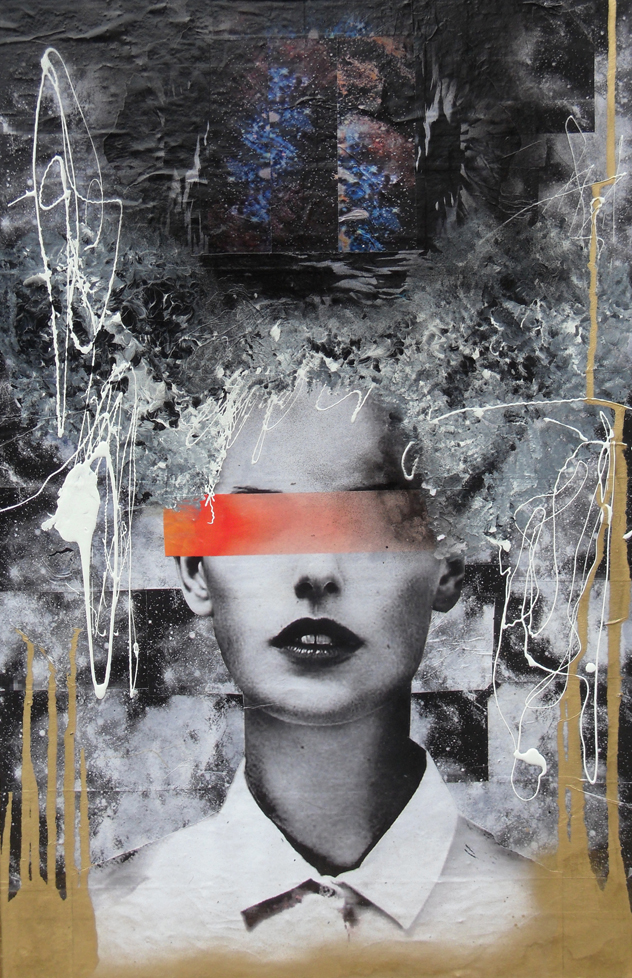
Photographer Nicholas Wray showcases his journey to Japan in new exhibition and book
Hailing from the intersection of the Ohio and Licking rivers, former geographer-turned-photographer Nicholas Wray is no stranger to picking up and hitting the open road. From moving from Cincinnati to Sacramento in 2006 to shooting the arid plains of Zion National Park, Wray’s penchant for exploration doesn’t only fuel his artistic passion but feeds his professional endeavors as well.
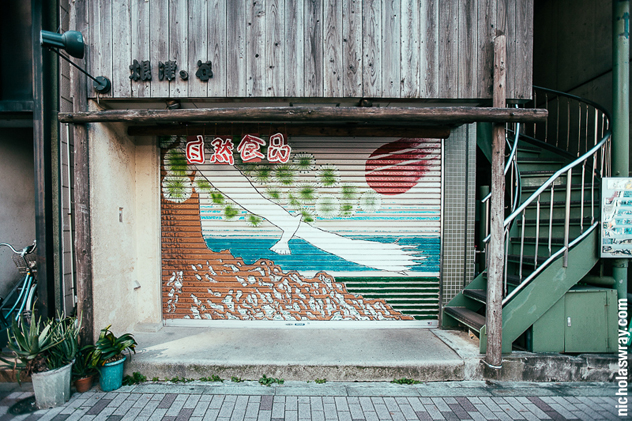
The proof is in his latest exhibition, simply titled Japan, in which his candid and colorful images of everyday street life in the Land of the Rising Sun adorn the walls of each of the three Insight Coffee Roasters locations. And, at the behest of a friend at the coffee shop, the photos were also assembled into a photo book worthy of adorning the best coffee tables in the world. The series, divided into five sections and scattered between the trio of coffee houses, touches on the many highlights of Wray’s travels: “Architecture,” “Culture,” “Street Life,” “Graffiti” and “Bicycles.”
“Whenever I travel I do this. I have a lot of prints at my studio and tons of photos that just kind of live on my server, so this was the first time that I have printed them super small and priced them super cheap so that people can afford them easily,” Wray explains.

Although the Ohio transplant rolled up to the interview on a motorcycle and sporting a weathered leather jacket, Wray isn’t brash or cocky. Quite the contrary, his quiet demeanor and unassuming nature bucks many of the stereotypes that are typically associated with those working behind the lens. You won’t find him sexually harassing models, attending the incessant parade of networking events that so many artists find themselves engaged in or stroking his own ego.
“This is the first time that I’ve done a show this big, like three coffee shops. I know it’s just coffee shops, it’s not a gallery—I mean I wish I was as cool as someone like Micah Crandall-Bear [and] had Elliott Fouts Gallery showing my stuff every month, but I’m just not that cool,” he says with a wry grin.

Wray’s journey into mastering shutter speeds and F-stops began as his college career was winding down at Northern Kentucky University. After applying for graduation he was advised, a few months shy of claiming his cap and gown, that he needed a minor in order to secure his degree. Uninterested in spending thousands more in man hours and cash, he leafed through the course catalog and it occurred to him that he could revisit his childhood hobby while locking down a minor—photography. He immersed himself in the course work: shooting in black and white film, rolling his own film, editing and enlarging images in the dark room and within a year acquired that prized piece of paper validating his education.

“I think I pretty much took really bad photos up until my very last class,” Wray muses. “That’s when I kind of started doing this street photography. I was in school, working like three jobs and the only time I had [to shoot] was at night. I was out in the snow at night without a tripod just shooting hand-held on film so I made this series of photos of laundromats all over Cincinnati.”
From skateboarders to musicians to commercial products, Wray’s professional portfolio is a robust exploration of the people and places that contribute to the diversity and color of Sacramento. If you’ve attended the annual summer concert series, Concerts in the Park, or witnessed the awesomeness that was this year’s TBD Fest, you may have even landed in the frame of one of his photos. But after years of hustling and struggling to turn his creative pursuits into a viable business, success brought with it an unexpected problem: He was overworked and in desperate need of a break.
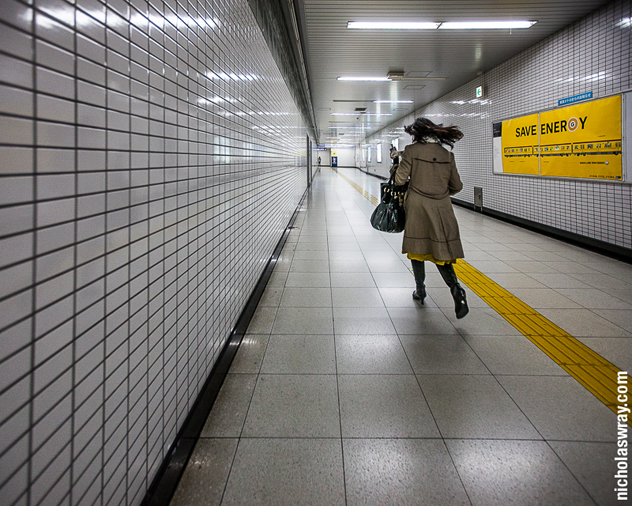
“So, I had been taking photos in Sacramento since 2009 and then after [my business] started to take off I was really, really busy for a couple of years,” Wray explains. “I was doing nothing but working—it felt like I was working 18-hour days, seven days a week—so I bought a plane ticket to Tokyo. I wanted to go somewhere super urban and really far away where I would have no understanding of the culture.”
So last October, after booking a ticket and packing his gear—consisting only of a backpack filled with a change of clothes, his camera, a couple of lenses and a laptop computer—Wray set out on a two-week tour of Japan, immersing himself into the culture and shooting everything in sight. Five thousand shots later, Wray had a collection of images depicting shimmering seascapes, people scurrying around the city going about their daily business, bicyclists snaking through traffic and gleaming skyscrapers towering above it all. And while he didn’t speak the language, Wray says his experience with the locals was nothing short of wonderful—from the hostel mother who picked him up on the side of the road to the hospitality of strangers taking him into their homes and feeding him, Wray was in good hands for the entirety of his adventure.
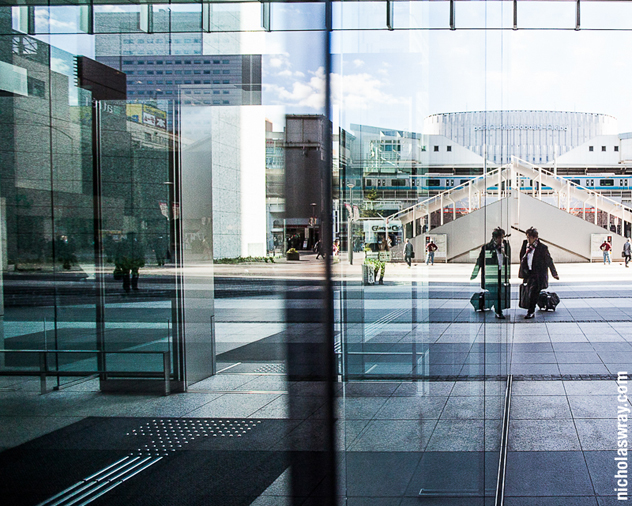
“People were really polite…just really nice people. I guess I shouldn’t be surprised by that—I guess I’m acknowledging that it was a really pleasant place to be,” he admits.
Upon Wray’s return, the images languished on his computer for months before he embarked on the arduous task of wading through the thousands of images captured on his journey and whittling them down into something manageable. Soon a series materialized and Wray decided that it was time for the images to emerge out of their cocoon and blossom out into the world. He presented the idea to his friend, Chris Ryan of Insight Coffee Roasters, to exhibit the work in each of its coffee dens, and after receiving an enthusiastic yes to his proposal the two began planning out the show.

The exhibit is a 145-image romp through the harried streets of Tokyo and Kyoto, the lush, verdant gardens that dot the countryside and everything else in between. Currently, you can find “Culture” at the Pavilions Café, “Street Life” and “Graffiti” at the Capitol Café, and “Bicycles” at the Southside Café. Wray says that the “Architecture” section of Japan will be included in the rotation but because of its sheer volume will make its debut at a later date.
“It’s kind of like a narcissistic pleasure of making a cool photo that someone else will enjoy,” Wray explains. “I think that the coolest thing for me is when someone sees one of my photos and they’re just like, ‘Oh my God, I have to have that!’ I know that they love that photo so much that they want to have it in their house. That’s my reward. It’s not about the money because I’m not making money on selling prints. Like this [show] costs me more than I’m ever going to get off it.”

Now that the exhibit is up, Wray reflects on his role as a member of the Sacramento art community. And while he’s carefully mapping out the location of his next photographic adventure, his time in Japan has reinvigorated the shutterbug.
“The way I look at my job is that I do mostly commercial photography for the market, and people pay me to take cool photos—they pay me to make art for their business,” Wray explains. “So sometimes I do something boring, like some product shot but…I make art all the time, it’s just consumed in a different way. It’s more like people commission me, kind of like a painter. Someone might commission a painter to make a painting, people commission me to make photos for their media.”

Nicholas Wray’s Japan is currently hanging around Sacramento at Insight’s Southside Café (1901 8th Street, Sacramento), Pavilions Café (566 Pavilions Lane, Sacramento) and Capitol Café (1014 10th Street, Sacramento). Wray’s Japan book can be purchased through the artist’s website, Nicholaswray.com.
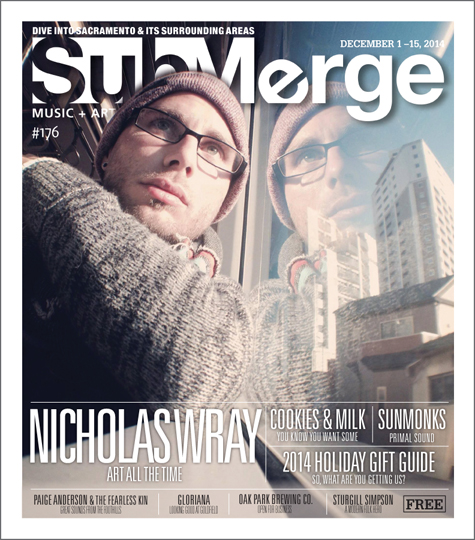
Lord Pawn balances his graffiti writing roots with his current life as a professional artist
I must have been about 9 years old when I practically shat my pants from my first real world run-in with street graffiti, or at least what my young mind imagined street graffiti to be at the time.
My brother and I were walking home from school in our cozy Elk Grove-bordering neighborhood when we turned a corner and instantly saw five big distorted letters plastered on the adjacent fence next to us.
Dripping in what seemed like only hours-old red spray paint, the looming letters looked something like this:

To this day, I’m still not sure if that sloppily written message was saying Fuck U, or simply telling me to beware of FuckO, the newest graffiti boy on the block.
Frankly, it didn’t really matter; what I saw bothered me. Images of older, meaner kids roaming around my neighborhood with spray cans ran through my head as I pictured myself having to deal with one or all of them somewhere in the near future.
My childhood got a good gut check that day over what turned out to be nothing more than a one-time amateur tag job. What I witnessed was most likely done by a first-timer who might have just gotten a hold of his first can of spray paint and wanted to let loose on the nozzle for a thrill that, for some, only a canister of color and aerosol can offer.
Twenty-eight-year-old Sacramento graffiti artist Ryan Kroger, who officially paints under the name Lord Pawn, knows that feeling all too well.
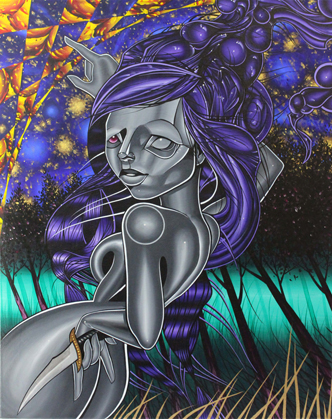
Growing up all over Northern California and eventually settling in Sacramento, Pawn says he’s been painting for as long as he can remember.
“It’s something that I loved to do and I just figured it out on my own,” he says. “And honestly, I don’t paint the way you’re really supposed to because I don’t really follow the rules that I was taught in school… I feel like with art, you can kind of break the rules sometimes.”
Pawn says he remembers the days when he too was just a punk kid running around with a skateboard in one hand and a marker pen in the other. It wasn’t long, though, before he discovered spray paint and began writing his graffiti name on any surface he could get his can on.
As he grew older, Pawn ran with a few different graffiti crews in town, going where he wanted and tagging what he wanted. But it wasn’t until he got with Ain’t Life Beautiful (ALB) and, eventually, accepted into the world renowned Legends of Rare Designs (LORDS) that he started to slow down a bit.
“I feel like it’s something I did in the past, and sort of something everyone has to go through at one point,” he says. “So I mean, like, I do miss it, ‘cause there’s nothing more fun than running out on the freeway and bombing stuff. But, I guess I just can’t really do that anymore.”
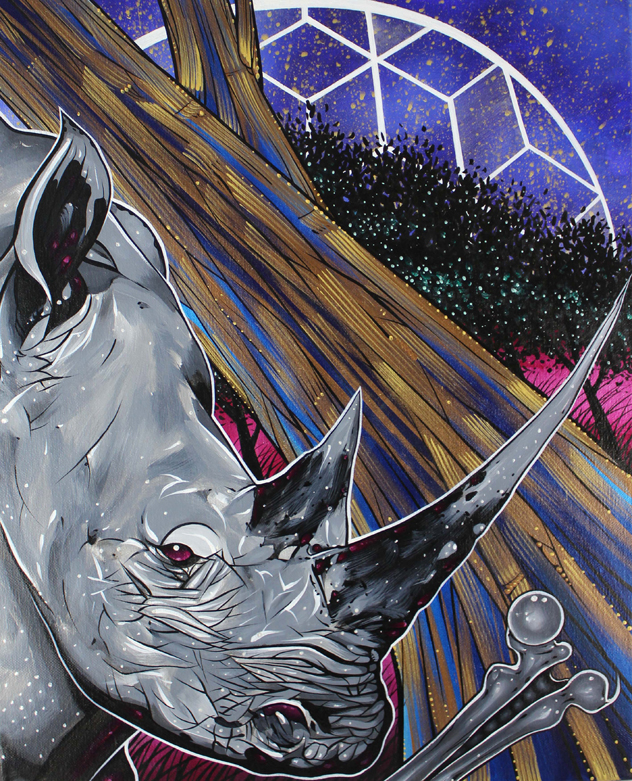
It’s true. Not only is Pawn well beyond his juvenile years, but he is also a professional artist now—in spray paint and acrylics—with a reputation to maintain and commissions to lock down.
“At least in this town, I’m getting murals and stuff like that,” he says of his recent work flow. “And I don’t want to be someone the cops are after or anything.”
Pawn says he’s been fortunate enough to secure work consistently over the past few years, painting mostly character murals for companies like Red Bull, Technine, Tropicana, Sacramento Mustang and even the Sacramento Kings.
He also does residential and commercial murals for smaller businesses, like a close-up piece he did of a girl’s face for Dabstix—a smoke shop in Roseville—about a year-and-a-half ago.
Ironically, sometimes even graffiti abatement programs will hire him to spray paint over an entire wall in hopes of deterring other taggers from constantly ruining it. Apparently, the backwards strategy works.
“So they’ll pay for me to put a mural on [a wall], and the kids will respect it—they won’t go and tag it anymore,” Pawn says. “Then the business doesn’t have to pay to paint over it every week. So it’s like a good thing for everybody.”
As focused as Pawn has been on his successful painting career lately, he says he still gets the itch to the hit the streets every now and then when his days get to be a little too mundane.
“Sometimes it’s good to be in a grimy place,” he says. “I’ve seen some crazy stuff just going and painting… You get stories out of it all; you’re going on adventures.”
Pawn says some of the best graffiti is done under the radar, usually in the cuts of any given city. Even now, he doesn’t take issue with painting in these remote areas, so long as it’s out of the way and not hurting anyone.
“You’re sort of out where nobody else goes. You explore a little bit, find a spot you can paint and you don’t have to be clean necessarily,” he explains. “You can just go and do it. And then you leave something beautiful behind that’s pretty. And people have to find it for themselves.”
At this point in his life, Pawn has struck a good balance between grime and convention.

While he says he’s mainly interested in traveling the world to pursue a legitimate art profession from here on out, he’ll still find himself at rail yards at times painting massive concept projects on train cars with at least one other fellow writer—what he and other graffiti artists call themselves.
Pawn says he knows the consequences of painting over trains, which can become a federal offense if they go over state lines.
“If you get caught, you can get in a lot of trouble,” he says. “But I don’t know. It’s like, to me, it’s sort of something that I’m willing to risk because it’s not like… you’re not a real criminal. You know? You’re not stealing, you’re not hurting anyone. It’s artwork.”
Pawn’s personal time isn’t always spent out painting the town red, however. He’ll actually stay home pretty often to work on more detailed pieces that he eventually puts up for sale.
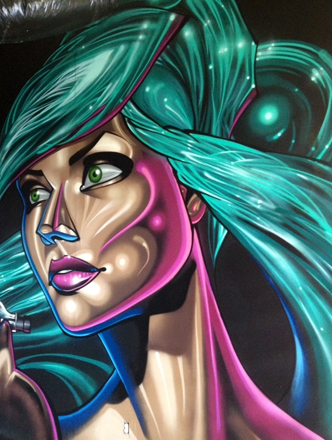
In fact, his very first art show was held this past Saturday, Nov. 8, at The Bench Art Supply and Gallery on 12th Street, where more than 20 original pieces—some acrylic, some spray paint—were on display and up for grabs to the public.
Prices went as low as $25 for prints to $5,000 for original works. His $5,000 piece—a 72-by-24-inch acrylic painting he spent a whole year working on—had already sold before the night’s end.
Pawn says he wants to do more art shows—not just for himself, but for the Sacramento art scene as a whole, which he thinks has potential to flourish.
“I think that there’s a lot to offer in Sacramento, but there’s just not that much of an art scene here, and there could be,” he says. “It’d be cool to start having some bigger artists coming through this city.”
Whether he stays in Sacramento to turn the art culture around or heads overseas to further his career, Pawn is sure to bring something new and exciting to the table in whatever scene he becomes a part of.
It’s funny how someone who produces such gigantic, surreal works of art can sport such a small name. But Pawn thinks it suits him.
“For me, it’s more of like a humble thing, you know? Because everybody wants to be a king, and really, we’re all just kind of like pawns—we’re the peasants,” he says. “There’s a saying that goes like, ‘The pawn is the most powerful chess player on the board,’ or something like that. Just because there’s many of you.”

Lord Pawn’s show at The Bench Art Supply and Gallery, located at 906 12th Street in Sacramento, runs now through Nov. 22, so if you haven’t gotten there to see it, we urge you to hurry it up! While you’re at it, follow Lord Porn on Instagram @PawnPaint. That’s what the cool kids are doing.
L.A. artist Mary Younakof puts the crayon big box to shame
Mary Younakof grew up in Los Angeles, but it took her latest artistic endeavor to see her city beyond what she previously viewed as just another congested metropolis.
343 Dresses: The Chromatic Convergence Project spotlights the random splashes of color camouflaged in L.A.’s concrete jungle. To do this, Younakof spent a year sewing 343 dresses—49 different tones of the seven colors of ROYGBIV (red, orange, yellow, green, blue, ivory and violet)—and staking out color-corresponding areas of L.A. to pose in for photos and videos.
The point, at first, was to depict the rainbow and L.A. in a new way; but over the last five years, as Younakof’s ideas continue to form around the dresses, the project has become more of a study of human interaction, the effect of color on the mind and much more.
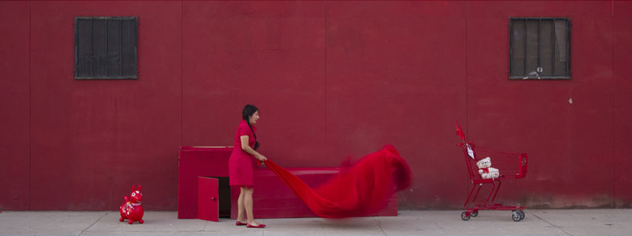
“It’s a project that has its own mind,” she says. “I initially had this very strict idea of how it was going to be. I thought, I’m going to make a dress every day and wear a dress every day but I realized that was impossible so I waited a year to make all the dresses first. I tried to direct the project but the project directed me.”
She started by researching the historical uses of rainbows in art and this eventually led to research on how people perceive colors.
“It’s almost like one step led to the next step and I spent almost one year creating the concept,” she says. “It was so big I needed to create a really specific formula for working with it.”
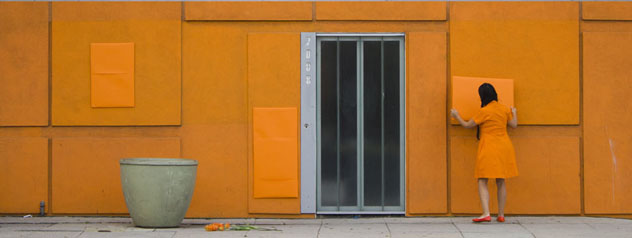
Younakof thus decided to use the number seven as the structure for the project because it was the number of colors in ROYGBIV, and because it seemed to naturally occur around her. The 343 dresses she created each have seven pieces to help keep with the theme.
“I was really interested in creating a dress that would have shape, form and mass,” she says. “It would be me against the landscape for the most part so I wanted to create form that is a little more sculptural. I thought, how can I use as much fabric as I can that takes up cubic space?”
To avoid walking around in a box, Younakof created a very simple but elegant pattern in seven pieces.

“It’s very distinctive and sculptural and people identified with it as the project unfolded because it was cohesive with the character I created,” she explains. “There were a lot of factors involved in designing that dress. A lot was driven by cost. I created something with no zippers or buttons. I wanted to do it simply.”
The dress became initially like a one-person performance piece. Younakof grew to love wearing each one, because she became a character within her own project and it felt like dressing up every day—but in the same thing. Only the textile changed the concept of the dress. Sometimes satin, other times taffeta or simple cotton.
“The textiles changed the mood of the dress,” Younakof says. “It felt different wearing a pink satin dress one day and a pink cotton dress the next.”
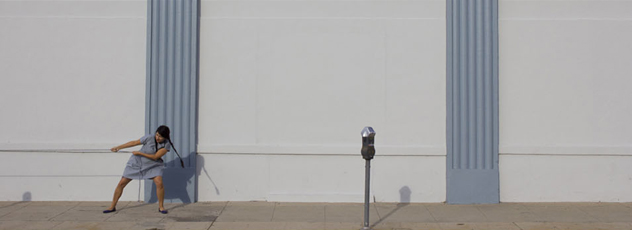
Younakof found the effects of the colors on other people most interesting. Complete strangers would often approach and tell her how they felt about the color.
“To have such a personal experience with it was really a much more powerful thing,” she says. “People migrate toward different colors and talk about them and have color associations and have nostalgia. I was not telling the stories, I was being told the stories.”
One of her favorite moments was a brief encounter with someone who simply wanted to identify with her, even without a story. “I remember walking into the market to buy groceries and the doors open, and I walk to the produce and this guy is pointing and waving his hand, and I’m like, who is he talking to? And I realize he is pointing at me. And then I point to me and he points to him and he is wearing an orange sweatshirt and I’m wearing an orange dress and we are 20 feet away from each other and just smile in understanding. Those interactions are the most fun.”

Before she started the project, red was Younakof’s favorite color. But after she began 343 Dresses, orange became her favorite because it attracted the most people to her.
“People tell me ‘Oh gosh, it reminds me of the orange teddy bear I had’ or their bedroom that was painted orange—there were very specific associations with the color orange,” she says. “But I think of all the colors I wore my favorites to wear were the hot pinks, because you don’t wear hot pink often. But the color orange compelled people to talk to me. The kind of stories that were told were heartfelt stories. I enjoyed wearing colors of pink that I wouldn’t get to wear but I really enjoyed orange because of what it brought to me.”
Conversely, she adds, she was horrified to wear some colors, like Shrek green.

“I was horrified but then it wasn’t that bad,” she laughs. “People looked at me and then went on their way.”
Along with her change in feelings for colors, Younakof changed her perspective on her home during the first year of wearing her dresses.
“It’s made me really focus on how color is integrated into the landscape,” she says. “Typically my experience of the city is you’re always dealing with traffic, trying to get somewhere, so this is looking at the city with a different pair of glasses. What was exciting for me was when I started to identify these colors in buildings while driving, or wherever I was, I noticed a lot of vibrant colors that people used on their buildings to create their place in the city. When you start to look you notice that other cities are not quite as colorful. Los Angeles is such a large metropolis associated with traffic and congestion but my project caused me to slow down and see my city in a microscopic way.”
Younakof’s photos and videos taken throughout the last few years do cause a double-take—she did not paint those sides of buildings with bright reds and blues, or purposely place a gigantic yellow smiley face on a truck in the middle of a parking lot. She made her environment pop—where before, it just blended into the background noise.

After her year of dress wearing ended, Younakof installed the pieces, outfits and all, at the Pacific Design Center in West Hollywood. Shortly after, galleries asked her to “perform” 343 Dresses and she incorporated the public into her project to showcase yet another aspect of how colorful life can be.
“Part of the initial concept was doing performances with a large group,” she says. “The first performance was an opera. I created this space in the Pacific Design Center where the [dress wearers] kind of spin around in space and create these color combinations based on numbers.”
Younakof worked with friends to create a composition based on the number seven. A German composer created the final piece and opera tenor Carlos de Antonis sang as members of the public performed around him. Since then, she has also performed in San Diego.

“I was invited to do some performances in San Diego so I invited the public to wear the dresses and they chose what colors they wanted to wear,” she says. “It’s interesting to see them create this community around the dresses. There were all ages and all genders. The last performance I had, had more men wearing the dress than ever. It was very exciting.”
[At the time of the interview] the Sacramento showing has not yet been fully planned, but Younakof says she is excited to take 343 Dresses somewhere different and see what happens in a different place.
“I think when people see it is an L.A.-based project and they see it through my eyes, they have said it could be so many places in the world,” she says. “And maybe that’s what happens in its own way, it brings together so many people who could be from anywhere. Just like L.A. is so diverse, it invites a very diverse crowd to come and be part of it. People are very attracted to color and they love seeing color. It was great to see people not knowing which dress to wear.”
343 Dresses started out about the spectrum of color in Younakof’s urban landscape, but as she continues to travel further out, she thinks more ideas will come to light.
“The beauty of it has kept inspiring me,” she says. “The ideas continue to come. It’s a project within a project within a project.”
To see what Younakof has in store for Sacramento, check out 343 Dresses: The Chromatic Convergence Project at the Verge Center for the Arts from Sept. 11 to Oct. 26, 2014. Opening reception is Sept. 11 from 6 to 9 p.m. For more info on the project and the artist, visit 343dresses.com.
Society through the Eyes of Jacqueline Gallagher
Jacqueline Gallagher wants to be taken seriously as an artist—just don’t take her art too seriously.
Gallagher sees the gorgeous and the grotesque in humanity, finds the comic relief and intricately recreates it in her oil paintings and drawings.
The centerpiece for her upcoming Sacramento solo show, Satirical Saturation, is a Fiji “Octomaid”—half a woman stitched to half a floppy, twisting tentacled creature.
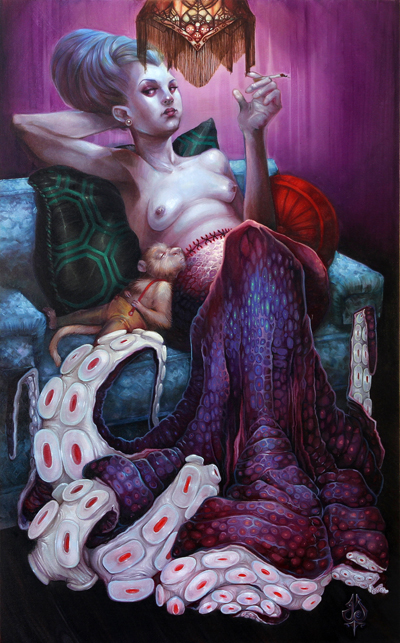
{Manganese Violet}
The segments’ details—human and octopus—sag and ooze realistically in purple and fleshy pink and a sleepy monkey completes the image.
“There’s a sexual element to it, too, that brings up the idea of fetishism and objectivity,” Gallagher says. “I post my work on various forums online for critique, and my favorite comment so far was on this piece. It was, ‘Pretty cool, I wish she was hotter but whatever.’”
Mythological characters influence her latest collection, specifically satyrs, Medusa, other gorgons and classic demons.
“The way I see it, people really haven’t changed much,” she says. “We’re still just as vain, overindulgent, self-interested, and decadent, and these characters, with their protruding horns and snakes, represent those very human traits.”
The show works off some of her previous paintings and exhibits, which have included candy-colored mermaids smoking with monkeys and deathly women covered in bugs but growing unicorn horns.
Earlier influences spring from her childhood in Hawaii, where Gallagher still resides. The islands still have a place in her work, which often portrays oceanic or jungle creatures. Or her house cats. What tourists might consider inspiration, however, Gallagher considered somewhat of a chokehold.
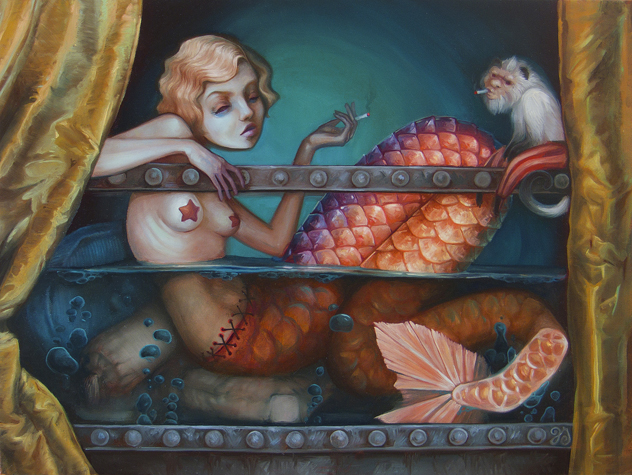
{Goldie Between Viewings}
“When I first started painting, everything was very Hawaii-oriented—ocean landscapes and flowers and all that and that’s what I started out painting because that’s all I saw,” Gallagher says. “In college, I started looking at work from out of the islands and got more inspired. I don’t know, it was actually kind of limiting growing up in Hawaii.”
Gallagher also worked in the commercial art business, and the kinds of customers she encountered sometimes ended up as inspiration for the flawed human condition represented in her work.
Japanese art, cartoons and anime also influenced her style as a kid, leading her to experiment exaggeration with bright colors and shapes.
“What’s funny is I try to make the paintings a little dark, since I’m really interested in opposition and mixing something really pretty with something really grotesque and slimy, but sometimes people don’t always get the humor,” Gallagher says. “I’ve seen some horror art and this is not even close.”
It’s been five years since Gallagher launched a website and started touring nationally with her work, exhibiting in San Francisco, Sacramento and Brooklyn galleries specializing in pop culture, macabre and surrealism.
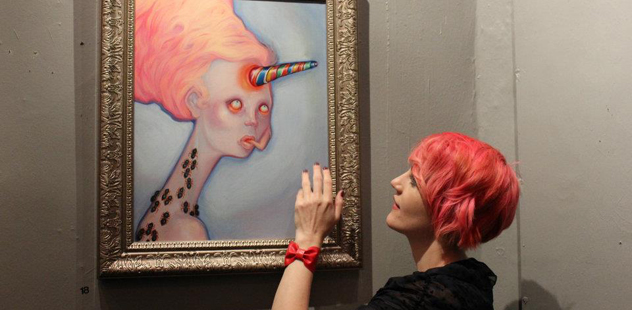
Over that time period, the 30-year-old has gained a strong fan base, which she credits to social media and Creep Machine Magazine, an online publication currently being reworked.
“I talked to this guy online, Joshua G., from Creep Machine, and he was really encouraging and he had me participate in a San Francisco show and got my website started too,” she says. “He just looked for art online and found me. That helped me jump off and get me on your coast there. It’s all social media that’s made it possible, really.”
Joshua had been scouring sites likes Deviantart.com when he stumbled upon Gallagher’s work and wanted to share and provide an interview for Creep Machine.
“The first painting I saw of Jackie’s was A Well Trimmed Bush,” he says, referencing a painting of a smoking woman in a lace dress with ghostly eyes and an equally ghostly-eyed cat.
“I loved the classic feel the painting had, the pose, and the attention to detail as seen in the drapery, lace, and skin tones,” Joshua says. “It’s a beautiful painting, but there is also a vibe of creepiness to it that draws you in, makes you want to see what else this artist has created.”
The web designer/art supporter says artists face economic challenges today that have made it harder to live off their work, and he feels it’s partly because the public consumes art differently.
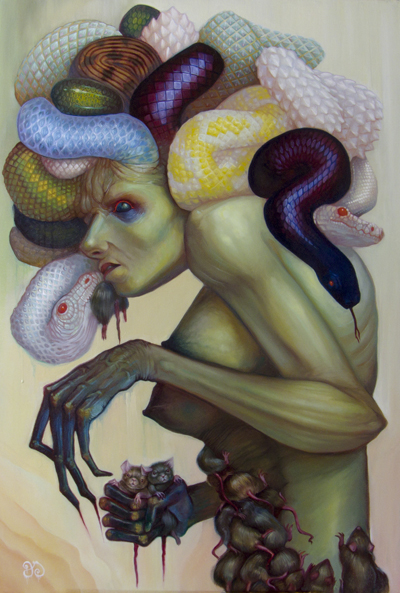
{Classic Medusa}
“So much art is consumed digitally now, and I think people need to remember that most of the time the work of art they are looking at, and sharing on social media, exists and might even be for sale,” he says. “Owning art is seen as a luxury to many people, but it is possible and can nurture and support the artists when people do buy the work. With that said, I think that darker forms of art are gaining in popularity. There are of course darker works that tend to be too much for people to buy and hang in their houses, but Jackie has done a great job of creating ‘dark’ works of art, that are also enticing.”
Joshua notes artists like Caravaggio and Francisco Goya (with his Disasters of War series), as well as Black Paintings from the 1800s as great examples of classical “dark art.” He says today’s movement takes more of a nod from pop culture trends.
“When you really dig deep you see that there is some amazing and beautiful works of art that are not created simply for the sake of being dark/shocking, but are telling stories, commenting on social and cultural issues, and in many ways helping the artists that create the imagery to deal with what they see around them,” he says.
Gallagher has successfully used social media and her website as storefronts for her artistic commentary, and currently lives off of her creations.
“It’s a really good time to be an artist right now because of social media,” she says. “It’s a good way for them to show off their work and a platform to meet other artists. It was good timing in my life, I guess.”
Gallagher says she doesn’t have much planned yet after her June 14, 2014, opening at Dragatomi in Sacramento.
She has started experimenting with other media and tools as well, and Oahu residents can often get lucky with a one-of-a-kind print at a monthly flea market the artist frequents with smaller, quickly created pieces. For the last few, she’s done everything from Wes Anderson characters to hot dog and hamburger monsters.
“I’ve been using watercolor and gouache a lot more lately and I’ve been kind of doing more graphic images with black ink and splashes of drippy color, so it’s less form and three-dimensionality,” she says.
She’d like to experiment with sculpture but continue to paint for a living.
“I like just having these solo shows sporadically but what I’d like to do is more nice quality prints and limited editions, so I’m trying to work on that.”
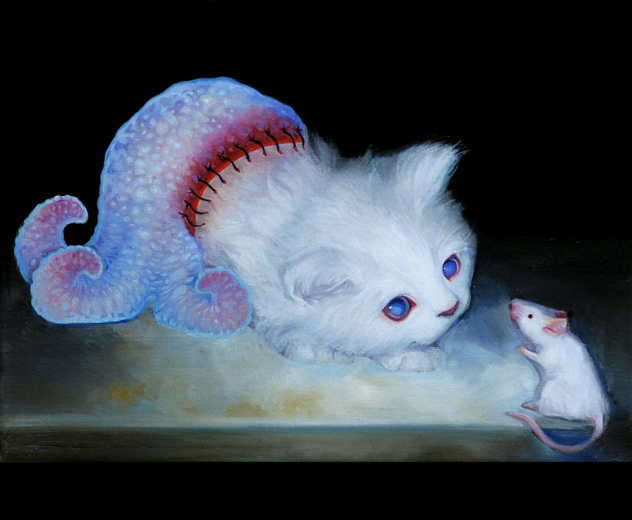
{Adolescent Octopussy}
Add Jacqueline Gallagher on Instagram, @Jackiepaintdead, to see her works in progress, her fun flea market prints and her cute kitties. Or, catch her starting June 14 through July 5, 2014 at Dragatomi, 2317 J Street, Sacramento.
Artist Susan J. Silvester finds a nurturing home in Sacramento
A blue-faced bunny girl clutching a limp, stuffed toy launched an entire series of artwork for Susan J. Silvester that she—and a growing number of fans—adores for its dramatic reflection of her dark, feminine voice.
Animals, imaginary lands, costumes, facial expressions and unusual body forms combine to represent Silvester’s self-proclaimed creepy genre.
The audience doesn’t really know if these forlorn, timeless beings are humans in fuzzy costumes or part human, part animal.
“They are sort of the same,” Silvester says from her home in Sacramento, where she does her digital work when not painting in her Verge Center for the Arts studio space. “I didn’t know that was going to happen but I’m a big fairytale and sci-fi fan (I love Dr. Who), so they’re human but they’re not. It’s creepy. It’s sort of based on medieval costumes that I saw and I learned how to sew. I do them kneeling a lot, so it’s an odd pose, because it’s kind of religious but kids do that a lot.”

Silvester’s first solo show, at Gallery 2110 and the Sacramento Art Complex, will be available to view next month and represents a psychological realm, another space that has to do with deep emotion and feeling. Think Pan’s Labyrinth meets 16th century portraiture.
At first, the art seems so sweet and delicate, and it is, but then it also conjures up feelings of entrapment and childhood confusion.
“I have a female voice, but then, I am a female,” says Silvester. “I just see that in the work, it expresses me. Even though these [faces] are not me they are me, because they are aspects of my personality, pieces of me.”
The first bunny girl was a result of a bad review she received while working on her master’s in painting at Sacramento State.
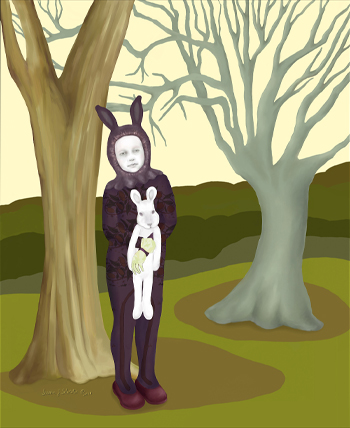
“Basically I got slammed in my review at school, and I got sad so I decided I’m going to draw people how I want to, and so I did,” she says. “I like people as animals. But it’s faux fur, it’s not real. I’m a vegetarian.”
The campus trees, squirrels and overall environment worked as a muse, as did Silvester’s more than 30 years of experience that ranged from Web design to art fabrication and replication animation.
Some of the particulars of these jobs are incredible. Silvester has built massive fiberglass sculptures for the Macy’s Thanksgiving Day Parade, created objects like children’s toys for comic strip Family Circle and designed the Rock and Roll Hall of Fame website.
Her artistic ability and dark humor came in handy when she worked on Pee-wee’s Playhouse and the Back to the Future ride at Universal Studios. Perhaps more impressive, however, was her work as an art fabricator in New York—her home state—for leading pop artists Robert Rauschenberg, Tom Wesselmann, Marisol and Lynda Benglis.
“As an artist, especially in New York, you just survive,” she says of the experience. “That was all sort of dark and wacky, so my work is still playful and dark.”
While working on the Back to the Future ride, Silvester decided to go back to computers and stop making large models as she had been for sets and other artists.
“I probably created enough toxic waste to last 100 million years,” she says. “I made a set that was 30-by-70 feet out of that foam that never breaks down and it was huge and disgusting. There were these huge bugs that came out of it. It was horrible. I said that’s it, I’m done with this, and then transitioned into computers. It was a good call.”
Silvester feels her digital work is almost more difficult than painting because she sees every flaw magnified.
“It’s really labor intensive and a lot of people don’t understand but this is all hand drawn,” she says of her digital work. Sometimes I’ll scan in my drawing but then I still have to paint it. I touch every part of that freaking piece. And when you flatten things (in Photoshop) then you have to fix it. I’ll still print something out and will see something and no one else will but I know it’s there. When I started painting, I kind of missed the ‘undo.’”
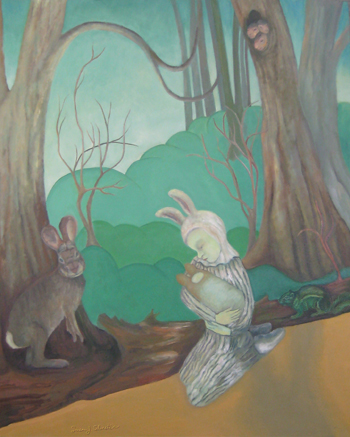
Silvester paints using mixed media, acrylics and oil. She has also recently incorporated her sculpting skills into her solo genre, sculpting bunny girls using clay and covering them with felt. If she completes the pieces, she may also include them in her show.
“I’m trying to show where I started and where I’m going so it’ll be interesting and help round out the show,” she says.
When she’s not in her studio or feverishly fixing every line and dot on her digital drawings, Silvester is teaching at the Art Institute, a job that has helped her go beyond “just surviving” as she did years ago in New York.
“Now I can do my art because I have that [the teaching],” she says. Silvester teaches color theory, drawing and design at the institute and also instructs senior classes at the Natomas Art Center in Folsom.
The art scene in Sacramento is also more her pace, Silvester says, after honing her career in both New York and Dallas.
“Since I moved here in 2001, the art scene has changed so much,” she says. “It’s expanded but it’s still a core group. I like knowing the different artists and seeing what they’re doing.”
She adds that attending school in Sacramento and having a studio at Verge has also positively affected her work and given her the confidence and feedback she needs.
“It has been a good place for me and we just kind of share ideas and critiques, so it’s really great for artists.”
Check out Gallery 2110 this July to see more of Silvester’s creations. A reception will be held July 13, 2013 from 6 to 9 p.m. Visit Susansilvester.com to follow her work.
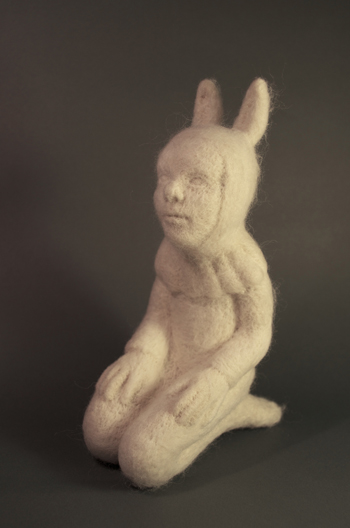
Speaking in front of people scares Corey Bernhardt. So does tattooing, painting and producing comic books. But he does all four.
“I like to challenge myself,” the Sacramento native says. “Tattooing scares the shit out of me, but that’s why I do it. That’s why I paint. I make this statement, ‘I’m gonna do this’ and it scares me to talk in front people but that’s why I love it.”
He admits to being scared of this interview too, but along with his ability to face his fears, Bernhardt knows he wants to connect with people and to learn from experiences and mistakes.
He also knows that all he’s ever wanted to be since he learned to read is a comic book illustrator.
“I had a friend who lived down the street when I was 5 or 6 years old and he had three or four comic books, and I was instantly blown away,” says Bernhardt, now 32. “He gave them to me probably because all I wanted to do was look at them when I went to his house, and I just read them front to back over and over again and started trying to emulate the illustrations.”
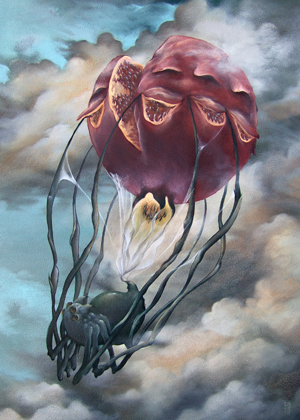
Bernhardt didn’t release his first creator-owned comic book Cardboard City, until 2010, some 15 years after his childhood comic experience. The short-lived action sci-fi publication with a robot as a main character received mixed reviews.
“I made a lot of mistakes,” he says. “I had never done a comic book before. I had trouble drawing certain things, or the pacing wasn’t right. I want to take what’s there and rework it and re-release it.”
Bernhardt loves storytelling and when he’s not painting, teaching or tattooing, he is home storyboarding and figuring out characters.
He started his professional art training in his early 20s, when a friend got him an interview for a graphic design position at a Tower Records production office.
“I started at Tower Records—it was kind of like the evil empire, a bizarre work environment,” he says looking back. “When I started I had no real graphic design experience, I knew a little Photoshop, I was 20 or 21, but I took some of my work and titled the folder ‘Please hire me,’ and the person interviewing said ‘It’s not the best work, but I like your attitude.’”

Bernhardt learned from other graphic artists working at the office and later produced freelance work for local bands and businesses—flyers, stickers, whatever he could try.
Hoping to further hone his skills, Bernhardt studied illustration in 2005 at the Academy of Art in San Francisco. In 2009 his freelancing and illustration work landed him an apprenticeship at Pretty in Ink Tattoo in Roseville.
“I never in a million years thought I would be a tattoo artist,” Bernhardt says. “When I was 19 or 20, I had some friends say I should tattoo but I was intimidated by tattoo artists. I didn’t have that persona, didn’t think I could hang out with them. But through graphic design, I got into it.”
Along the way, Bernhardt found much respect for tattoo art and painting.
“What I like about tattooing is it allows me to crisscross back and forth between the art forms, switch gears and do more sequential work or illustration, then go to painting,” he says. “I can’t say I love one over the other. And I think that’s how art is going today. You have to be able to cross genres, put down the pencil and pick up a camera, then put down the camera and pick up a paintbrush. But it is hard to find a distinct style.”
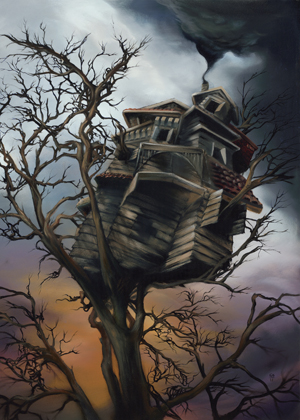
Bernhardt says he found his painting style, which reflects in his other work, when he first started putting oil on wood.
“I was never interested in painting—I just wanted to be a comic book illustrator—but when I started working at a tattoo shop, both tattoo artists I worked with were oil painting and they would bring out a canvas in between clients,” he says.
The practice intrigued him.
“With tattoos you would think it’s more about drawing, but it’s more like the fundamentals of painting, color theory, mixing colors,” he says. “Until I tried it I didn’t realize that. And when you work at a shop, you can put [your painting] behind you and a client will see it and might want it. It’s one more thing in your arsenal when you’re a freelance artist or independent contractor.”
So Bernhardt took a magnifying glass to his favorite artists’ prints and chose oil on wood to begin painting. A Circa Survive album cover inspired him, and he found out the artist had been Esao Andrews. His style, along with that of James Gleeson, left an impression.
“When I saw what those guys are doing I was like, yeah, that’s what I want to do,” he says enthusiastically. “It’s beautiful, grotesque, what I admire and I’m trying to emulate that kind of universe that they paint in. I think what made me so attached to that style of painting is when you see the painting, you want to be there, you want to see what it’s like to live there for a day.”
Bernhardt is more attracted to painting the bizarre in nature, using animals, insects and fruit.
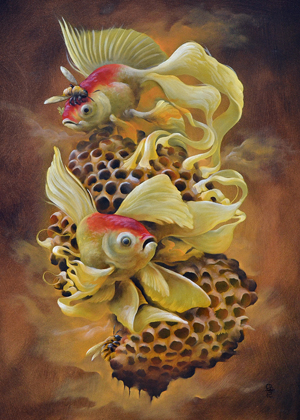
“I like to do bizarre things like put a fish in the sky, a bird under water,” he says. “It’s more a conceptual thing than a message. I’m not trying to convey a message, I’m just trying to get a feeling out of it.”
Bernhardt has only been practicing fine art for a couple years, but he has befriended a slew of Sacramento artists along the way. After connecting with local tattoo artist Jessica Ann White, and sharing with her a vision for a fine art gallery that also includes a tattoo shop, the two decided to open Reclamare Gallery and Custom Tattoo at 2737 Riverside Boulevard in Land Park.
The gallery will host pieces from both Bernhardt and White regularly, as well as from Andy Steele, Jared Tharp, Chris Bales, Jared Konopitski, Jacquelyn Bond, Jayme Goodwin, Andrew Luck, Jason Taylor, Kathryn Mayo and Joel Smith during April’s Second Saturday.
“I wanted to get people to keep coming to the shop and also help other local artists by being a hub,” Bernhardt says. “You see that nowadays, there will be a gallery but there will be a bar or something in it, so the gallery doesn’t draw a lot people but you can get them in for a drink. I wanted people to know this was for fine art. It’s a gallery for artists who happen to do tattoos.”
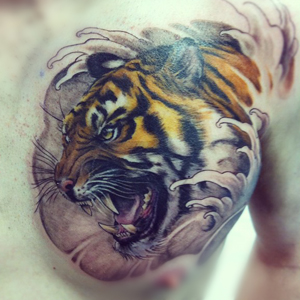
He also wanted a place to host local workshops, classes and artists who could teach painting, as a way to give back to the community that supported him. Currently, Bernhardt teaches figure drawing at University Art on Marconi Avenue.
“I just want for people to be comfortable and talk about art and not be intimidated by that whole culture,” he says of the new gallery.
Bernhardt is happy with the location of the gallery and shop because he doesn’t want to take away from the tattoo studios that have been established downtown, and because the gallery is in line with a few others in the immediate area.
“We’re also across the street from the cemetery, which is kind of creepy but it’s beautiful,” he says, noting he thought the shop might be haunted but took care of any possible spirits before opening.
Just another small scare along his path. No big deal.
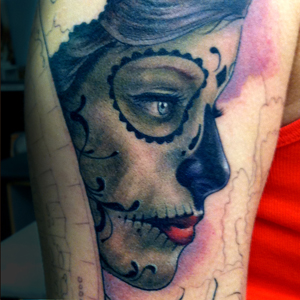
For more info, visit Reclamare’s little corner of Facebook, Facebook.com/Reclamaretattoo.
Justin Wood’s work shows the possibilities of the digital image
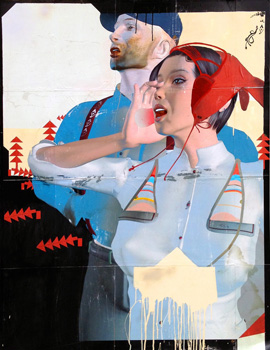
The Vocal, 2003
An olive-skinned woman with a smooth, red cap and jet black hair silently calls out into the distance; her piercing dark eyes are accented with the soft hint of blue balancing the crimson star shaped buttons of her button-up shirt. Just behind her, a man of medium build stands quietly in a comforting manner, a 5 o’clock shadow casting across his solemn face. Behind both these figures, red triangles bond together resembling pine trees and what starts as a lightly colored background of yellow sky blends into a darken abyss of black medium running off the end of the hanging canvas.
This piece of art titled The Vocal, along with dozens of others, is part of artist Justin Wood’s latest body of work, Family Affair, displayed throughout March at Midtown Village Café on 19th and I streets, Sacramento. And although The Vocal does contain some paint, this piece and all his work displayed was ultimately created on a computer at the hand of Wood, then printed and pasted to a canvas for all viewers.
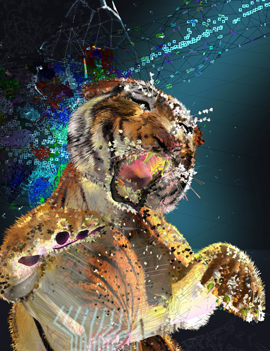
The University of Missouri’s Alumni Magazine, 2012
“What I’m really interested in is juxtaposition and mixing and smashing things together that don’t really work. The synergy between digital and analog is interesting,” describes Wood. “I was struck by the openness of [digital or mixed media] and that you could do so many different variations of everything you wanted to.”
The digitally crafted pieces that line the walls and hallway of the eclectic Midtown café log more than 10 years of Wood’s artistic career ranging from as far back as 2002, to a set of psychedelically colored women hanging toward the front of the business that he says were more recent. Wood credits his digitally contrived dexterity to his parents, his mom being an abstract painter, and his father, a computer software programmer.
“There’s this big mix between mom doing traditional painting and my dad hackin’ on the computer all the time,” explains Wood. “I think that’s kind of how my interests sort of came together or how the aesthetic came together in a way.”
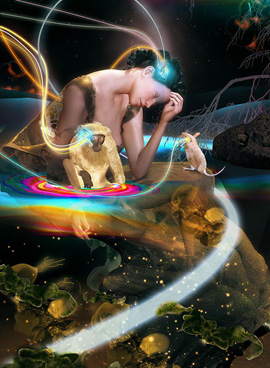
Optogenetics, WIRED Magazine, Oct. 2009
Wood’s father also had a heavy influence in the early development of MIDI music, a computer software capable of not only allowing musical instruments to communicate with each other, but giving one instrument the ability to control another or multiples. Just think, if a piano is programmed to play a G-note, then a trumpet, or clarinet or whatever other instrument available would also follow suit. Technology, people, it’s rad.
But, despite how sharp, intense or intriguing Wood’s images are, the measurement of effort when it comes to digitally crafted work within the art community and between art enthusiasts remains indifferent. On more than one occasion during art shows, Wood found himself facing loaded questions from viewers like, “Where’s the skill?” or “Where’s the craft?” It’s an attitude he’s grown all too familiar with since displaying his work in galleries in San Francisco, Los Angeles and even Germany.
“Just because you work on the computer, it’s not just pressing buttons. It’s not just saying, ‘Do this,’” says Wood of his creative process. “But, everyone couldn’t get over the fact that I was doing art digitally. So, I would try to sell my work in galleries and people would be like, ‘Oh, so you just press the art button?’”
The art button.

Divers, 2012
Wood compares this imaginary art button odium to photography, asking critics if a photographer is just a mere, talentless dreamer armed with a fancy mechanical device and a shutter-happy trigger finger?
“It’s a huge stigma because people don’t understand how you do it. You know it takes a hell of a lot of effort to make a good photograph,” says Wood. “You might get lucky once in a while, but you have to be a really good photographer with a great subject to make a really compelling photograph.”
When Wood isn’t defending his digitally driven creative methods, he’s drafting editorial illustrations for various national and international publications like The New York Times, Money magazine and also reaching overseas with Men’s Health magazine in Germany. He candidly admits choosing art as a career proves difficult financially at times, especially with his budding family to provide for in wife Laura and two-year-old daughter, Ida.
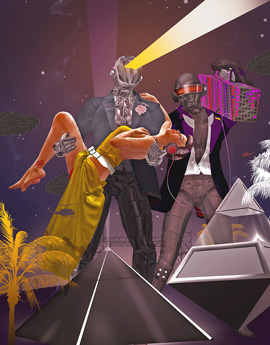
Daft Punks, Las Vegas Weekly, 2007
“I thought if I’m going to be an artist, I’ve got to be able to put bread on the table,” says Wood. “My mom was an artist and we were dirt poor. [She’s] always telling me how sorry she is about where we grew up. But it gives you experiences that you cannot get anywhere else and new ways to look at and appreciate things. It was important for me to be able to figure out how to at least make a little bit of money.”
His wife Laura is an architect who explores art freely in her spare time and coincidentally, has several pieces of her handcrafted art displayed at Midtown Village Café alongside her husband, and she also has an installation inside the California Museum on O Street standing over 10 feet tall. Inside the café, her oblong-shaped mobiles hang from the ceiling or are mounted against walls in various colors reflecting light and embracing the shadows their cardboard angles create.

Justin and Laura Wood
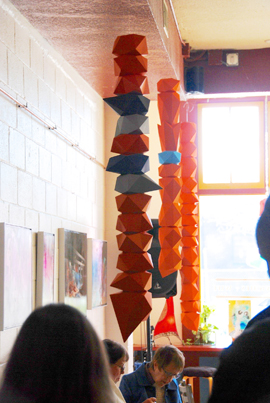
Laura Wood’s hanging mobiles
“We have a similar aesthetic, but it’s totally from different ends of the spectrum,” says Wood. “She’s not into pretty pictures…she’s into figuring out how these forms relate to space and how to manifest them in 3-D. It’s inspiring.”
Still, Wood’s affinity toward the digital realm versus the more analog will never stop him from defending his techniques because while he enjoys creating from a computer screen, he often finishes his work with paint. He explains this push and pull between mediums as a reoccurring conflict while creating art digitally, but often finds himself slightly returning to the physical when he finishes a piece with paint and physically displays it at a small café or gallery.
“I hope that there is this certain struggle that is illustrated in the work, which is where do we fit in this new, digital world,” asks Wood, who then poses these questions for critics of the digital and mixed media art process.
“Do you like the image? Do you find the image compelling? Do you find it interesting? Do you find it controversial? Yes? OK, then, does it matter,” he says.
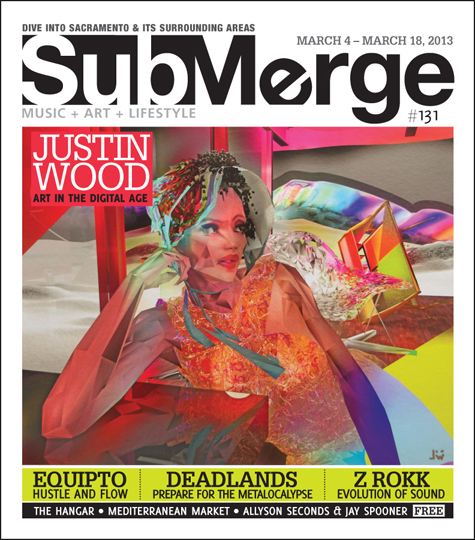
It’s a Family Affair, Justin Wood’s joint show with his wife Laura, is now open for viewing at Midtown Village Café in Sacramento. Midtown Village Café is open seven days a week and is located at 1920 I Street. For more information on Wood, visit his website http://www.singlecell.to/.

By Daniel Block
Put on by Alison Kranz and local photographer Nicholas Wray (who frequently contributes to Submerge), 400×400 is a proximity based photo project where the organizers asked for community contributions that would capture the character of our city block-by-block. “The idea for 400×400 is to get people–even people who wouldn’t necessarily consider themselves photographers–out, walking around and observing the city surrounding them,” Kranz told Submerge.
“We heard about a couple projects doing something very similar and decided it was something Sacramento needed,” Wray added.
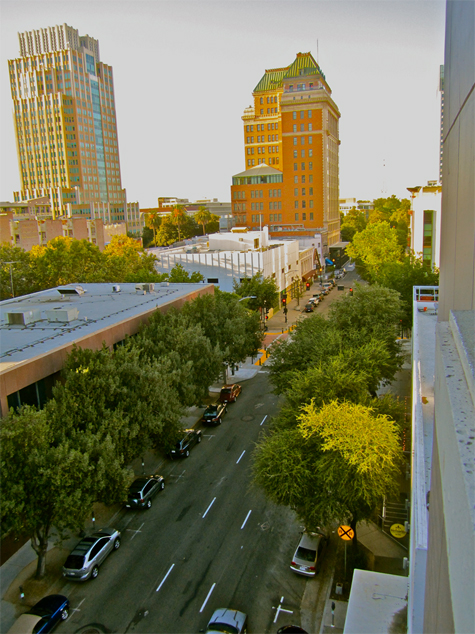
By Sara Cain
With our downtown/Midtown blocks being approximately 400 feet by 400 feet, the organizers want each installment of 400×400 to focus on just one block at a time around where the host venue is for the next showing. For September’s show, which will take place at Broadacre Coffee (1014 10th Street) starting on Saturday, Sept. 8, 2012, they asked local photographers of all levels, from camera phone junkies to pro camera toters, to focus on the block around Broadacre between 9th and 10th streets and J and K streets. “The clouds, the buildings, the sidewalks, the people, anything is fair game as long as it is within the perimeter of the block,” Kranz said.
If you’d like to take part in 400×400, “like” it at http://www.facebook.com/400×400 or visit 400×400.com to learn more about how to submit your photo(s) and to learn which block will be the next to be featured. Kranz and Wray hope to make it a recurring thing. “We would like to do every block in downtown/Midtown,” Wray said. “And then we’ll start over if people like doing it!”
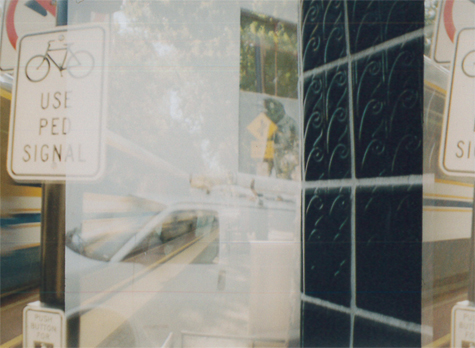
By Jason Tarman









